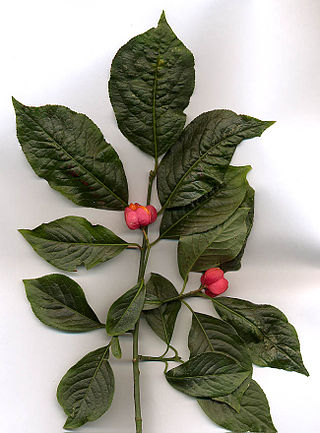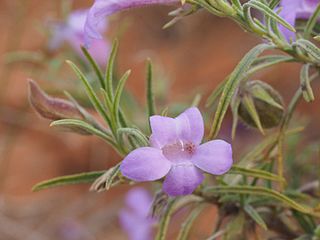
Forsythia, is a genus of flowering plants in the olive family Oleaceae. There are about 11 species, mostly native to eastern Asia, but one native to southeastern Europe. Forsythia – also one of the plant's common names – is named after William Forsyth.

Euonymus is a genus of flowering plants in the staff vine family, Celastraceae. Common names vary widely among different species and between different English-speaking countries, but include spindle, burning-bush, strawberry-bush, wahoo, wintercreeper, or simply euonymus. It comprises about 130 species of deciduous and evergreen shrubs, small trees and lianas. They are mostly native to East Asia, extending to the Himalayas, and they are also distributed in Europe, Australasia, North America, and Madagascar. 50 species are endemic to China.

Trachycarpus is a genus of eleven species of palms native to Asia, from the Himalaya east to eastern China. They are fan palms, with the leaves with a bare petiole terminating in a rounded fan of numerous leaflets. The leaf bases produce persistent fibres that often give the trunk a characteristic hairy appearance. All species are dioecious, with male and female flowers produced on separate plants although female plants will sometimes produce male flowers, allowing occasional self-pollination.

Ilex mucronata, the mountain holly or catberry, is a species of holly native to eastern North America, from Newfoundland west to Minnesota, and south to Maryland and West Virginia.

Mentha arvensis, the corn mint, field mint, or wild mint, is a species of flowering plant in the mint family Lamiaceae. It has a circumboreal distribution, being native to the temperate regions of Europe and western and central Asia, east to the Himalaya and eastern Siberia, and North America. Mentha canadensis, the related species, is also included in Mentha arvensis by some authors as two varieties, M. arvensis var. glabrata Fernald and M. arvensis var. piperascens Malinv. ex L. H. Bailey.

Vinca major, with the common names bigleaf periwinkle, large periwinkle, greater periwinkle and blue periwinkle, is a species of flowering plant in the family Apocynaceae, native to the western Mediterranean. Growing to 25 cm (10 in) tall and spreading indefinitely, it is an evergreen perennial, frequently used in cultivation as groundcover.

Euonymus fortunei, the spindle, Fortune's spindle, winter creeper or wintercreeper, is a species of flowering plant in the family Celastraceae, native to east Asia, including China, Korea, the Philippines and Japan. It is named after the Scottish botanist and plant explorer Robert Fortune. E. fortunei is highly invasive and damaging in the United States, causing the death of trees and forest in urban areas.

Acer monspessulanum, the Montpellier maple, is a species of maple native to the Mediterranean region from Morocco and Portugal in the west, to Turkey, Syria, Lebanon, and Israel in the east, and north to the Jura Mountains in France and the Eifel in Germany.

Fraxinus mandshurica, the Manchurian ash, is a species of Fraxinus native to northeastern Asia in northern China, Korea, Japan and southeastern Russia.

Sorbus glabrescens is a species of rowan native to Yunnan in China.

Mahonia fortunei is a species of shrubs in the family Berberidaceae, the barberry family, described as a species in 1846. It is endemic to China, found in the provinces of Chongqing, Guangxi, Guizhou, Hubei, Hunan, Jiangxi, Sichuan, Taiwan, and Zhejiang. It is grown as an ornamental in many lands, with common names including Chinese mahonia, Fortune's mahonia, and holly grape.

Acacia burkittii is a species of wattle endemic to Western Australia, South Australia and western New South Wales, where it is found in arid zones, and is a perennial shrub in the family Fabaceae. Common names for it include Burkitt's wattle, fine leaf jam, gunderbluey, pin bush and sandhill wattle. It has also been introduced into India. Previously this species was referred to as Acacia acuminata subsp. burkittii, but is now considered to be a separate species. Grows in mallee, eucalypt and mulga woodland or shrubland, often on sandhills.

Acer hyrcanum is a maple species sometimes referred to as Balkan maple. It grows in southeastern Europe and western Asia.
Iris dolichosiphon is a plant species in the genus Iris, it is also in the subgenus Iris and in the section Pseudoregelia. It is a rhizomatous perennial, from China and Bhutan. It has long, thin dark green leaves, very short stem, and dark blue, purple, or violet flowers. That are mottled with white. It has thick white/orange beards. It has one subspecies, Iris dolichosiphon subsp. orientalis, from China, India and Burma. It has similar flowers. They are cultivated as ornamental plants in temperate regions

Eremophila gilesii, commonly known Charleville turkey bush, green turkey bush, desert fuchsia and Giles emu bush is a flowering plant in the figwort family, Scrophulariaceae and is endemic to Australia. It is usually a low, spreading shrub with pinkish-lilac to purple flowers and is widespread in the Northern Territory and all mainland states except Victoria. It is considered a difficult agricultural weed in some parts of Queensland but is often used as a bush medicine by Aboriginal people.

Daphne papyracea is a shrub, of the family Thymelaeaceae. It is evergreen, and is found across Asia, from Pakistan through central Nepal to China. Generally it is found at elevations from 700 to 3,100 metres. Daphne laciniata from Yunnan has been treated as a separate species or as part of D. papyracea.

Tilia carolinianaMill. is a species of tree in the family Malvaceae native to the southern and south-eastern states of the U.S., and Mexico.

Salix pedicellata is a species of willow. It is a shrub or small tree to about 6–8 m tall, native around the Mediterranean Sea from Portugal to Lebanon and Syria in the north and from the Canary Islands to Tunisia in the south. Salix canariensis may be treated as a subspecies of S. pedicellata.
Salix daguanensis is a shrub in the willow genus Salix with 4 to 8 centimeter long leaf blades. The natural range of the species is in China.
Salix delavayana is a shrub or small tree from the genus willow (Salix) with mostly 3 to 8 centimeters long leaf blades. The natural range of the species is in the south of China and in Tibet.

















